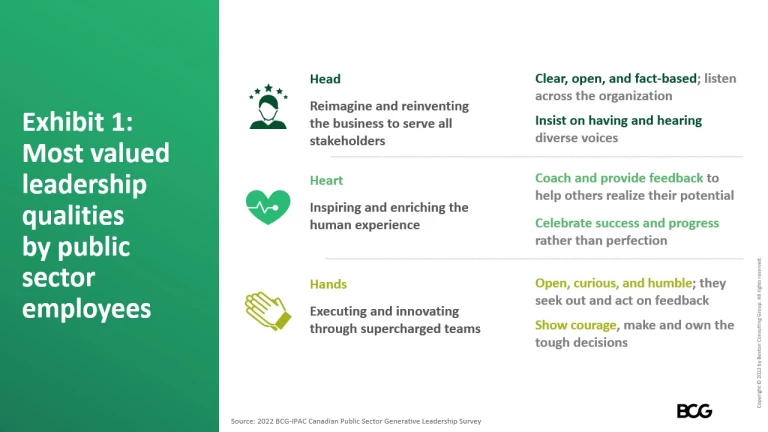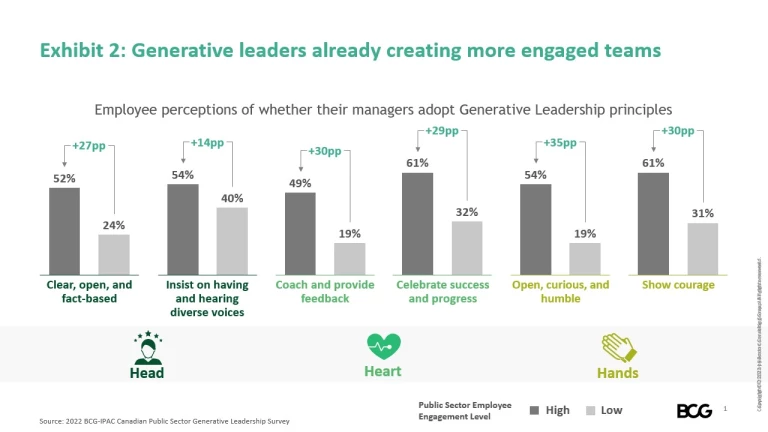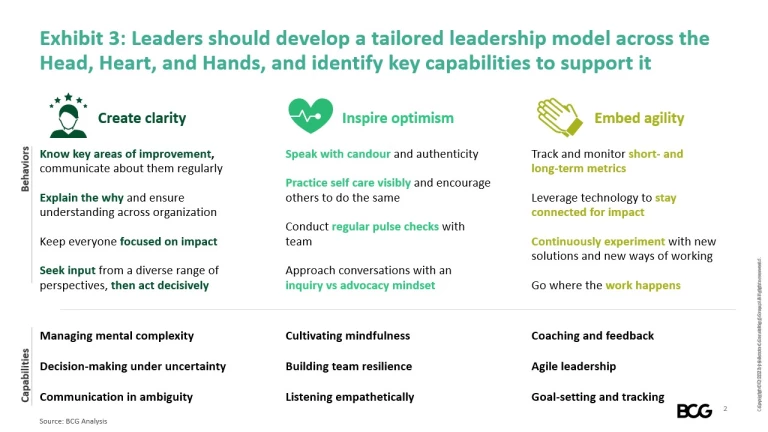The quality of public sector leadership matters now more than ever, but the nature of that leadership has to evolve.
The world as we’ve known it has changed drastically and Canada’s public sector faces challenges scarcely imaginable a decade ago. External forces are making the world much more complex, among them the pandemic, digital innovation, supply chain and labour shortages, climate change, and a long overdue reckoning with structural racism and generational harm. Internal forces are also increasingly challenging to manage. Policies have higher stakes, more sweeping impact, and are all the more difficult to get right given the long-term timeframes associated with traditional methods of policy planning, design, and implementation. Navigating Reconciliation and devising anti-racism strategies will take deeper personal engagement and greater skill. Public sector executives must develop a more diverse and inclusive workforce and lean in like never before to support employee mental health and wellness. Executives have to manage these commitments while juggling the demands of a hybrid workforce and delivering reliable, high-quality, human-centered service to and for the benefit of Canadians.
Canada has a chance—and an imperative—to create a more inclusive and prosperous country but doing so will require a distinct leadership approach. This is the time for public sector organizations to embrace Generative Leadership, a humanistic framework that cultivates renewal and growth, and has been successfully put to the test during periods of acute change.
Generative Leadership Generates Results
Boston Consulting Group (BCG) has been studying the characteristics that contribute to above-average performance and employee satisfaction for the last several years.
We have surveyed more than 9,000 professionals worldwide and, recently, in partnership with the Institute of Public Administration of Canada completed an additional survey of 750 public sector professionals across Canada to generate the insights in this article. What we’ve learned is that the most transformative leaders create the conditions for success based on three core principles. (See Exhibit 1)

- Lead with the head: Generative Leaders continually reimagine and reinvent ways for their organizations to better serve all stakeholders. They look expansively at what is required, set a bold vision, and focus on a few big priorities that can deliver maximum value. But they don’t set that course on their own. They insist on having diverse voices in the room, test ideas from multiple angles, and shape initiatives that provide measurable returns.
- Lead with heart: Generative Leaders are purpose leaders who create a culture in which people can do their best work while being coached and recognized for it. They care deeply for the physical, social, and mental wellbeing of people at all levels of their organization. They understand and demonstrate the importance of diversity, inclusion, and recognition, ensuring that people feel seen, heard, and valued.
- Lead with the hand: Generative Leaders are all-in, action-oriented, and accountability-minded. They enable success by deploying people into agile, project-based teams, and augment their capabilities through digital tools and an ecosystem of partners. They lead by example, step up to make the tough choices, encourage testing and learning, and allocate resources dynamically to areas of highest value.
Far from soft talk, our analysis finds a direct correlation between employee motivation and the practice of Generative Leadership. In our Canadian public sector survey, we found that 61% percent of employees whose leaders celebrated their successes reported being highly engaged in their work, compared to less than 32% of employees in organizations slower to recognize individual contributions. Likewise, 54% of employees in public sector organizations whose leadership approached teaming in an open, curious and humble manner said they were highly motivated to engage versus just 19% in organizations whose leaders did not. (See Exhibit 2)

What’s more, Canada’s public sector has already shown that it works. The pandemic was a litmus test.
More than three-quarters (77%) of public sector employees in Canada said that in periods of tremendous strain—the height of the COVID-19 crisis, the urgency to address racial discrimination and bias following the murder of George Floyd, and renewed pressure for Reconciliation following the discovery of additional unmarked Indigenous graves—that their leaders showed up, supported their teams and lived up to their expectations. In these uncertain and often frightening times, Canadian public sector executives communicated sincerely and provided guidance on an ongoing basis. They demonstrated creativity in implementing new ways of working, flexibility in adapting to change, and went out of their way to care for their people. In short, when the times called for transformative leadership, leaders instinctively reached for Generative Leadership.
Generative Leadership Must Be Woven into the Fabric
While there’s growing awareness in public sector organizations that a growth mindset, committed coaching, and diverse and empowered teams deliver better outcomes, few have pulled these threads together into a unified leadership model that all are encouraged, supported, and enabled to use. In self assessments, close to 30% of leaders acknowledged that they do not practice the principles of Generative Leadership. And those that give themselves high marks often rate themselves more favourably than do their direct reports.
Now is the time for public sector organizations to embed Generative Leadership practices into their culture and operational fabric in a way that more effectively connects with team members. In our research, employees cited several gaps they’d like their leaders to address. One is for executives to be bolder in defining a strategic ambition. A senior executive told us, “We must foster leaders with the willingness and ability to define vision.”
Employees are also looking for their leaders to be more deliberate and entertain opposing viewpoints before committing to a course of action. In addition, employees want to see more opportunities for learning and greater openness to risk-taking and experimentation. Rather than perpetuating tried—and sometimes tired—approaches, employees we spoke with said they are craving the space to shake things up and use their creativity to design better solutions. They also want to see their leaders be courageous, as well as make and own the tough decisions. Action orientation, delivery of results, and accountability are critical. As is the ability for leaders to ‘roll up their sleeves’ with their teams to get things done and have real impact.
Another gap that employees cited is the need for connection. They want leaders who engage authentically, guide with empathy, and speak with candour. And they want to see role models who live out their values, take time for health and wellness and who, by their example, give others permission to do the same.
To bring about this culture, public sector organizations will need to evolve significantly, value leadership as a discipline and practice, and invest in leadership development – for the current generation of leaders and the one that follows. Leadership at every level is a mindset and behaviour that should be cultivated long before employees secure their first executive position and when they do secure it, a formal program of development should be in place to support and enable leaders to be at their best.
Right now, however, our survey found that only 13% of respondents “often or always” receive leadership training and 56% “rarely or never” receive it. As one public sector official told us, “If we are not talking about leadership, how do we expect to get better at it?” This training needs to permeate every level of the organization. We need to be training tomorrow’s leaders today so they arrive into their roles practiced, ready to drive the organization forward and inspire the generation of leaders that follow. And that training needs to be systematic.

The development and delivery of Generative Leadership development programs ought to be grounded in programming that helps current and future leaders develop and refine the discipline of leading their teams with highly visible Head, Heart, Hand behaviours such as those highlighted in Exhibit 3.
To start, we recommend leaders and their teams spend time reflecting on the attributes of Generative Leadership and ask themselves, “What am I good at? What am I not good at? And where do I need support?” Find those in the organization who are passionate about leadership and supporting people. Then leverage that community of practice. Beyond this, we recommend the practice and discipline of leadership be recognized and valued as equal to that of policy development or program delivery and that an enterprise-wide programmatic approach be taken to invest in and develop leaders to innovate, equipping the Canadian public sector to be the best in the world. Public servants deserve it and Canada does, too.
Canada needs a thriving, inspired, healthy and engaged public sector to conceive and implement the policies and programs essential for inclusive growth and the country’s prosperity. Generative Leadership is central to that mission. By untapping the potential of people, public sector leaders will enable results to happen faster, and make the world a safer, healthier, and better place.









